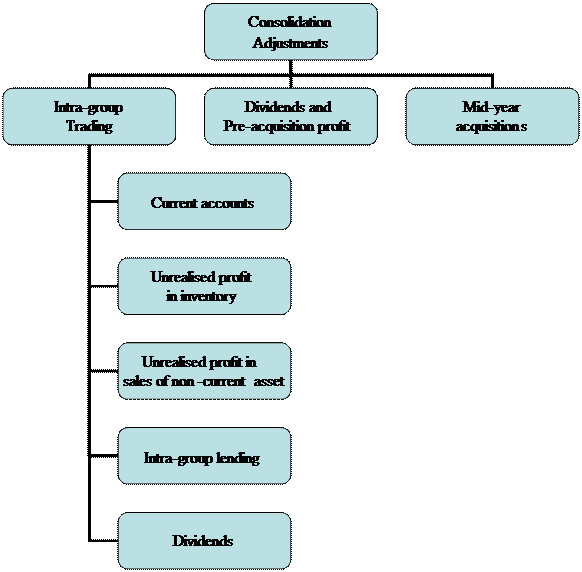Chapter 19 Consolidated Statement of Financial Position with Consolidated Adjustments
1. Objectives
1.1 Account for the effects of intra-group trading in the statement of financial position.
1.2 Explain why it is necessary to use fair values when preparing consolidated financial statements.
1.3 Account for the effects of fair values adjustments in consolidation.
1.4 Account for the effects of mid-year acquisition of subsidiary.


2. Intra-group Trading
2.1 Parent (P) and subsidiary (S) may well trade with each other leading to the following potential problem areas:
(a) Current account between parent and subsidiary
(b) Loans held by one company in the other
(c) Dividends and loan interest
(d) Unrealised profits on sales of inventory
(e) Unrealised profits on sales of non-current assets
(A) Current accounts
2.2 At the year end, current accounts may not agree, owing to the existence of in-transit items such as goods or cash.
2.3 |
Cash or goods in transit |
|
The usual rules are as follows: Cash in transit: Goods in transit: This adjustment is for the purpose of consolidation only. |
2.4 |
Example 1 – Intercompany current accounts |
|||||||||||||||||||||||||||||||||||||||||||||||||||||||||||||||||||||||||||||||||||||||||||||||||||||||||||||||||||||||||||||||||||||||||||||||||||||||||||||||||||||||||||||||||||||||||||||||||||
|
Below are the statements of financial position of H Ltd and S Ltd as at 31 December 2010:
Notes: Required: Prepare the consolidated statement of financial position of H Ltd as at 31 December 2010. Solution: W1 Shareholdings in S Ltd.
W2 Cash in transit
W3 Net asset of S Ltd
W4 Calculation of Goodwill
W5 Non-controlling interest
W6 Group retained earnings
Consolidated statement of financial position as at 31 December 2010
|
(B) Unrealised profit in inventory
2.5 Where goods have been sold by one group company to another at a profit and some of these goods are still in the purchaser’s inventory at the year end, then the profit loading on these goods is unrealized from the viewpoint of the group as a whole. This is because we are treating the group as if it is a single entity. No-one can make a profit by trading with himself.
2.6 |
Adjustments for unrealized profit in inventory |
|
The process to adjust is: Adjustment required: 2. If the seller is the subsidiary, the profit element is included in the subsidiary company’s accounts and relates partly to the group, partly to non-controlling interests. Adjustments required: |
2.7 |
Exercise 1 – Unrealised profit in inventory |
|||||||||||||||||||||||||||||||||||||||||||||||||||||||||
|
H Ltd bought 90% of the equity share capital of S Ltd, two years ago on 1 January 2009 when the retained earnings of S Ltd stood at $5,000. Statements of financial position at the year end of 31 December 2010 as follows:
S Ltd transferred goods to H Ltd at a transfer price of $18,000 at a mark-up of 50%. Two-thirds remained in inventory at the year end. The current account in H Ltd and S Ltd stood at $22,000 on that day. Goodwill has suffered an impairment of $10,000. H Ltd uses the fair value method to value the non-controlling interest. The fair value of the non-controlling interest at acquisition was $4,000. Required: Prepare the consolidated statement of financial position of H Ltd as at 31 December 2010. |
(C) Unrealised profit in sale of non-current assets
2.8 If one group member sells non-current assets to another group member, adjustments must be made to recreate the situation that would have existed if the sale had not occurred:
(a) There would have been no profit on the sale.
(b) Depreciation would have been based on the original cost of the asset to the group.
2.9 |
Adjustments for unrealized profit in sale of non-current assets |
|
Two consolidation adjustments will usually be needed to achieve this. In practice, these steps are combined so that the retained earnings of the entity making the unrealized profit are debited with the unrealized profit less the additional depreciation. The double entry is as follows Dr Group retained earnings (deduct the profit in W6) 2. Sale by subsidiary Dr Group retained earnings (deduct the profit in W3 at reporting date) |
2.10 |
Example 2 – Unrealised profit in non-current asset |
|||||||||||||||||||||||||||||||||||||
|
H Ltd transfers an item of plant to its subsidiary (S Ltd) for $6,000 at the start of 2010. The plant originally cost of $10,000 and had an original useful economic life of 5 years when purchased 3 years ago. The useful economic life of the asset has not changed as a result of the transfer. Required: Calculate the unrealized profit on the transaction at the end of the year of transfer (2010). Solution:
The overall adjustment would be $1,000 at the reporting date. To adjust the accounts:
|
(D) Dividends paid by subsidiary
2.11 When a subsidiary company pays a dividend during the year the accounting treatment is not difficult. Suppose S Ltd, a 60% subsidiary of H Ltd, pays a dividend of $1,000 on the last day of its accounting period. Its total reserves before paying the dividend stood at $5,000.
(a) $400 of the dividend is paid to non-controlling shareholders. The cash leaves the group and will not appear anywhere in the consolidated statement of financial position.
(b) The parent company receives $600 of the dividend, debiting cash and crediting profit or loss. This will be cancelled on consolidation.
(c) The remaining balance of retained earnings in S Co's statement of financial position ($4,000) will be consolidated in the normal way. The group's share (60% × $4,000 = $2,400) will be included in group retained earnings in the statement of financial position; the non-controlling interest share (40% × $4,000 = $1,600) is credited to the non-controlling interest account in the statement of financial position.
(E) Intra-group lending
2.12 As a result of intra-group lending one group company will show a loan in their statement of financial position and another group company will show an investment (or receivable).
2.13 On consolidation these should be eliminated against each other and are therefore not added across to form part of group borrowings or group investments.
3. Dividends and Pre-acquisition Profits
3.1 The parent company, as a member of the subsidiary, is entitled to its share of the dividends paid but it is necessary to decide whether or not these dividends come out of the pre-acquisition profits of the subsidiary.
3.2 If the dividend is paid from pre-acquisition profits, the double entry is being as follows:
Dr Cash
Cr Investment in subsidiary
In other words, it reduces the cost of the parent company’s investment.
3.3 |
Example 3 – Dividends paid from pre-acquisition of the subsidiary |
||||||||||||||||||||||||||||||
|
P acquires a 60% interest in S on 1 September 2010. S's year end is 31 December. On 10 January 2011 S pays a dividend of $10,000 in respect of 2010. P's share of the dividend is $6,000. However, as it relates to the year of acquisition, $2,000 (6,000 × 4/12) is treated as being from post-acquisition profits and $4,000 (6,000 × 8/12) is treated as being from pre-acquisition profits. Why do we make this distinction? If we consider the situation of a holding company deciding whether to invest in a subsidiary, we can see the significance of a dividend paid from pre-acquisition profits. If the prospective subsidiary's financial statements disclose that it proposes to pay a dividend in the near future, the prospective holding company knows that if it invests in the shares some of its investment will be returned to it very soon. Also, a dividend paid out of pre-acquisition profits cannot be regarded as a return on the company's investment because it relates to the period before the investment was made. So we treat it as what it effectively is – a reduction in the cost of the investment. To continue the example, it assumes that P has paid $175,000 for its 60% shareholding in S. At the date of acquisition S had share capital of $100,000 and retained earnings of $70,000. In 2011 S pays a $10,000 dividend of which P receives $6,000. $4,000 is deemed to be from pre-acquisition profits. The goodwill calculation at 31 December 2011 is as follows:
|
4. Mid-year Acquisitions
4.1 If a parent company acquires a subsidiary mid-year, the net assets at the date of acquisition must be calculated based on the net assets at the start of the subsidiary’s financial year plus the profits of up to the date of acquisition.
4.2 To calculate this it is normally assumed that subsidiary’s profit after tax accrues evenly over time.
4.3 |
Example 4 – Mid-year acquisition |
||||||||||||||||||||||||||||||||||||||||||||||||||||||||||||||||||||||||||||||||||||||||||||||||||||||||||||||||||||||||||||||||||||||||||||||||||||||||||||||||||||||||||||||||||||||||||||||||||||||||||||||||||||||||||||||||||||||||||||||||||||||||
|
On 1 May 2010 H Ltd bought 60% of S Ltd paying $76,000 cash. The summarized statements of financial position for the two companies as at 30 November 2010 are:
The following information is relevant: (1) The inventory of S Ltd includes $8,000 of goods purchased from H Ltd at cost plus 25%. Required: Prepare the consolidated statement of financial position of H Ltd as at 30 November 2010. Solution: W1 Shareholdings in S Ltd.
W2 Unrealised profit in inventory
W3 Transfer of plant from S Ltd to H Ltd Excessive depreciation = (15,000 – 10,000) / 5 years x 6/12 = $500 Net unrealized profit = 5,000 – 500 = $4,500
W4 Impairment of goodwill
W5 Loan note of S Ltd
W6 Cash in transit
W7 Net asset of S Ltd
Pre-acquisition profit = 60,000 + 9,000 x 5/12 = 63,750. W8 Goodwill
W9 Non-controlling interest
W10 Group retained earnings
Consolidated statement of financial positions as at 30 November 2010
|
||||||||||||||||||||||||||||||||||||||||||||||||||||||||||||||||||||||||||||||||||||||||||||||||||||||||||||||||||||||||||||||||||||||||||||||||||||||||||||||||||||||||||||||||||||||||||||||||||||||||||||||||||||||||||||||||||||||||||||||||||||||||
Source: https://hkiaatevening.yolasite.com/resources/F7Notes/Chapter19-ConSFPAdj.doc
Web site to visit: https://hkiaatevening.yolasite.com
Author of the text: indicated on the source document of the above text
If you are the author of the text above and you not agree to share your knowledge for teaching, research, scholarship (for fair use as indicated in the United States copyrigh low) please send us an e-mail and we will remove your text quickly. Fair use is a limitation and exception to the exclusive right granted by copyright law to the author of a creative work. In United States copyright law, fair use is a doctrine that permits limited use of copyrighted material without acquiring permission from the rights holders. Examples of fair use include commentary, search engines, criticism, news reporting, research, teaching, library archiving and scholarship. It provides for the legal, unlicensed citation or incorporation of copyrighted material in another author's work under a four-factor balancing test. (source: http://en.wikipedia.org/wiki/Fair_use)
The information of medicine and health contained in the site are of a general nature and purpose which is purely informative and for this reason may not replace in any case, the council of a doctor or a qualified entity legally to the profession.
The texts are the property of their respective authors and we thank them for giving us the opportunity to share for free to students, teachers and users of the Web their texts will used only for illustrative educational and scientific purposes only.
All the information in our site are given for nonprofit educational purposes